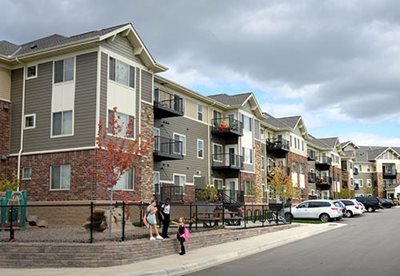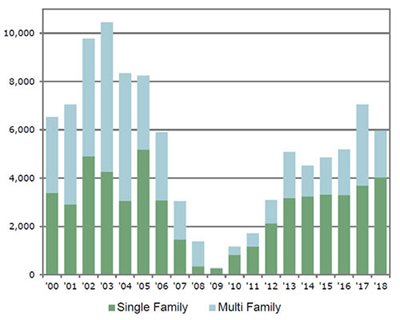Growing suburbs and rural centers outside of the metro region’s urban core are developing at densities consistent with Metropolitan Council policy and with their own comprehensive land-use plans.
 The Council’s net residential density target is a minimum of 3 units per acre for cities and townships designated in Thrive MSP 2040 as either suburban edge, emerging suburban edge, or rural center.
The Council’s net residential density target is a minimum of 3 units per acre for cities and townships designated in Thrive MSP 2040 as either suburban edge, emerging suburban edge, or rural center.
Reports of platting activity from 44 cities and 1 township for 2018 show an overall net density of residential development at 3.1 units per acre. Since the Council started monitoring platting activity in select cities starting in 2000, net density has ranged from a high of 5.3 units per acre (just before the housing market crash in 2008) to a low of 2.8 units per acre (2009). The average net residential density since 2000 has been 3.67 units per acre.
Local governments in the Council’s plat monitoring program that plat land at densities higher than 3 units per acre get credit, which allows them flexibility to respond to the market by platting at lower densities at other times or in other areas, explained Council Senior Planner Raya Esmaeili.
The 3.1 units per acre average for 2018 may reflect some underreporting, Esmaeili said. Local governments have been occupied preparing their 2040 comprehensive plan updates and may not have had time to report for 2018. The actual density average is likely higher, she said. Cities and townships are encouraged to catch up with their reporting in the future.
 Over time, slightly more single-family homes built
Over time, slightly more single-family homes built
Participating local governments also report the mix of single-family and multi-family housing units proposed in new or pending developments.
During 2018, 68% of the platted units were single family, for a total of 4,030 units. The share of multi-family units was 32%, or 1,934 units total. The composition of the housing mix since 2000, while varying from year to year, has averaged 54% single-family and 46% multi-family units.
Plat monitoring program is a ‘crucial implementation tool’
Reviewing local governments’ platting activity allows the Council to annually assess the supply of land available for development and determine whether cities are achieving Council density policy, as well as what they’ve committed to in their comprehensive plans.
“The plat monitoring program is a crucial implementation tool in reviewing comprehensive plan updates and amendments, and sewer extension permits,” Esmaeili said.
For example, if the Council reviews a sewer extension permit request for a development with a density of lower than three units per acre, the plat data for the requesting city or township is reviewed to make sure their overall residential density meets regional expectations.
Why is density important?
Orderly and efficient land uses lay the foundation for a prosperous region. To be fiscally responsible, the Council guides land use and development policies to ensure that use of big public infrastructure investments — like roads and sewer pipes — is maximized, which has both public and private benefits.
Making efficient use of land and capitalizing on existing infrastructure also reduce outward development pressures in rural and natural resource areas.
The region’s planning partnership between the Council and local governments, resulting in more orderly development, has many benefits. For example, it is a factor in why residents in the Twin Cities metro area pay wastewater treatment fees that are, on average, 40% lower than our peer regions.
A total of 44 cities and 1 township participate in the Met Council’s plat monitoring program. More than a dozen cities volunteered to participate at the start of the program in 2001, and it has continued to grow as the region has developed. The program was established with input from Metro Cities (then called the Association of Metropolitan Municipalities) and the Builders Association of the Twin Cities.
Read the 2018 Plat Monitoring Report (PDF)
Local planning assistance at the Council